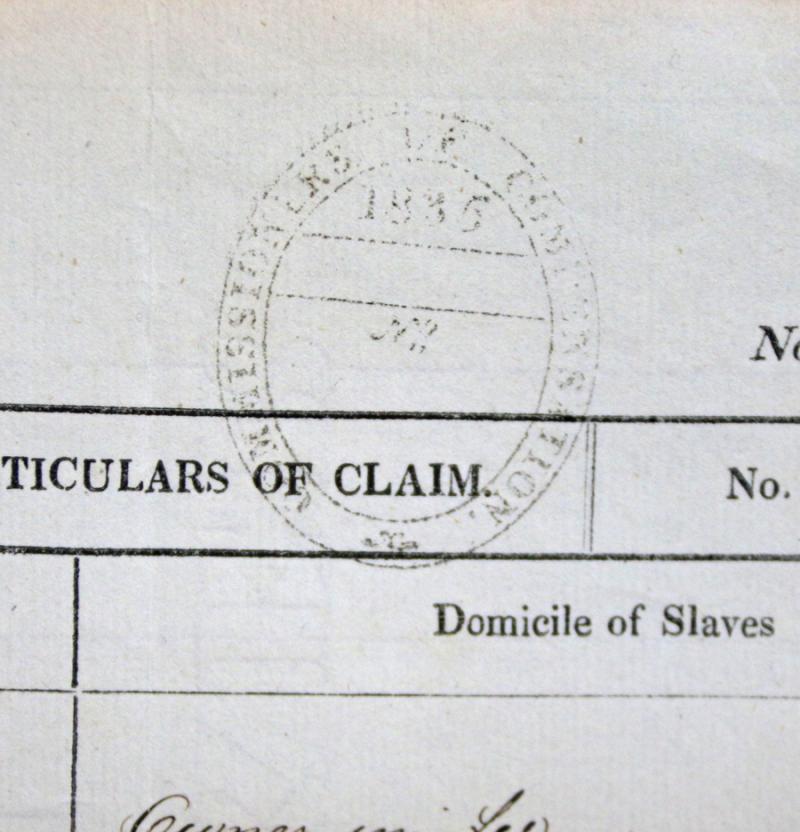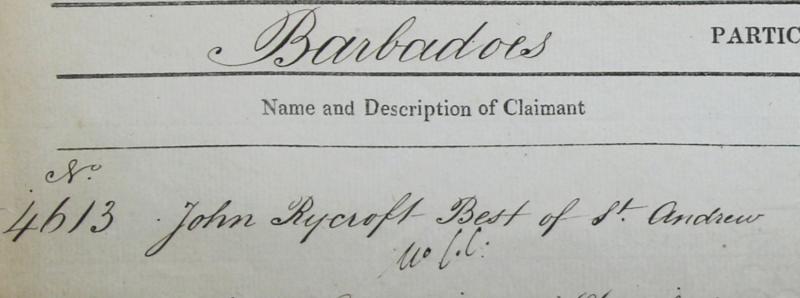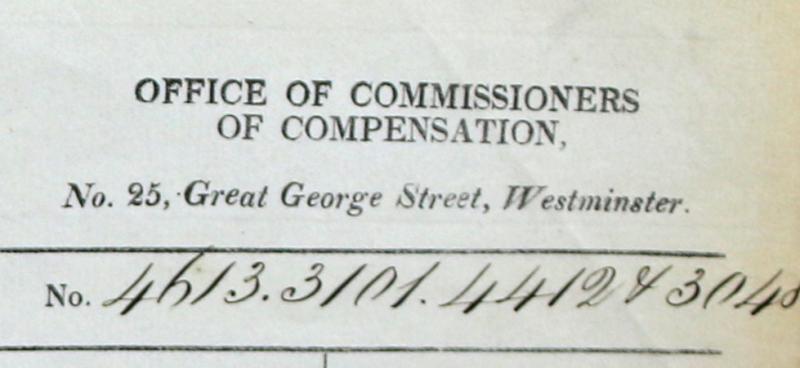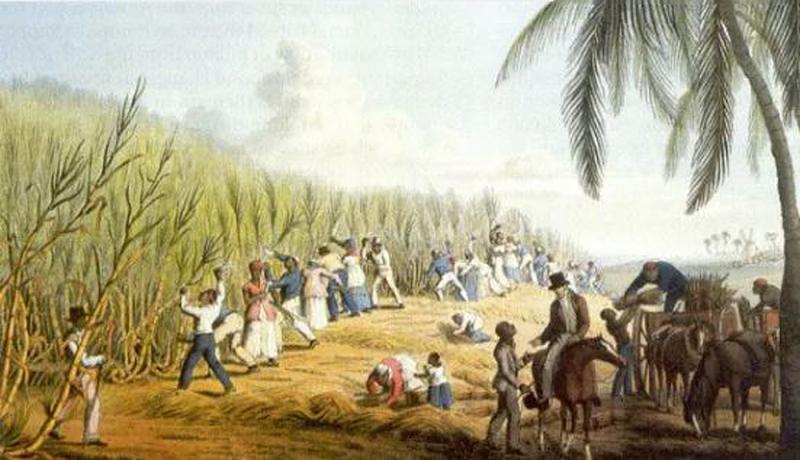An Extraordinary Document, & Piece of Original & Highly Relevant History Today. A 'Particulars of Claim For Compensation' For The Freedom of 253 Slaves In Barbados For the President Of Barbados, John Rycroft Best & 556 Slaves Owned By John Higginson
An original stamped and dated claim form. For John Rycroft Best’s 253 slaves in St Andrew, plus,, the numerous claims of John Higginson of Barbados
John Rycroft Best was a 'plantocrat' and militia commander who played an important part in the suppression of the Barbados rebellion of 1816, though he was to withdraw from the Barbados Assembly committee which reported on the uprising.
John Rycroft Best
recorded in official record as
‘of Blackmans, in the Parish of St Joseph, Barbadoes sic, President of this Island.’
He played an important role in Barbados Council politics including, for example, rallying opposition to the impending threat of abolition. At a meeting of representatives of Barbados, Antigua, Demerara and Essequibo, Dominica, Grenada, Nevis, St Christopher, St Vincent, Tobago and the Virgin islands, chaired by Best, there were strong protests against the British Government’s treatment of the West Indies, the threat of abolition (unless there was adequate recompense) and praise for how the planters had improved the conditions of the slaves.
John Rycroft Best was last recorded as perishing aged around 73 in a fire and subsequent explosion aboard RMS Amazon. Quite a lot of detail is known of this event, and we detail it as follows;
RMS Amazon was a wooden three-masted barque, paddle steamer and Royal Mail Ship of the Royal Mail Steam Packet Company. She was one of a set of five sister ships built at the beginning of the 1850s for RMSP's routes between Southampton and the Caribbean.
On Friday, 2 January 1852, Amazon, commanded by Captain William Symons, loaded mail, embarked 50 passengers and late that day she sailed for the Caribbean. In the next 24 hours she twice hove to as her engine bearings overheated. She entered the Bay of Biscay and about 12:40 on Sunday, 4 January, smoke was sighted rising from a hatch ahead of her forward funnel. Captain Symons and his chief officer, Roberts, were quickly on deck and organised crewmen with buckets and a hose to fight the fire. Men started to move hay away from the fire, but after they had moved only two bales all the remainder caught alight.
The fire spread out of control. The starboard lifeboat rescued the five occupants of the dinghy and tried to approach the ship to rescue more people, but came in danger of being swamped and so abandoned the attempt. Amazon was still under way, rolling in the heavy sea while Symons and his crew still tried to keep her course steady.
By 04:00 the fire brought down the ship's foremast and mainmast. At 05:00 her magazine exploded and her mizzen mast was brought down. Her funnels glowed red-hot6 and about half an hour later she sank about 110 miles (180 km) west-south-west of the Isles of Scilly.
On the same documentation are the details of John Higginson of St Philip and his approved compensation claim of his numerous properties and slaves therein, also the details of his claims finalised by his executor for his son, a naval captain, as he died long before the compensation was actually paid.
Details of one claim in public record of John Higginson of St Philip; 288 slaves, compenstion paid £2,491 10s 2d to Robert Richard Deane as executor of John Higginson's Estate
Richard Deane appears as the attorney of William Barton, George Irlam and John Higginson in Essequebo in 1808.
Enslaved persons were registered in 1834 by Richard Deane, as the attorney to John Higginson.
Deane appears in the Slave Compensation records mainly as the executor of John Higginson, the last of the original partners in Barton, Irlam and Higginson, who died in 1834.
Public record shows amounts claimed were £2,491 10s 2d for his Sandy Lane slaves and £3,594 10s 9d for his Congo Road slaves
From public record; 'In 1833 ... Barton, Irlam & Higginson owned a number of Barbadian plantations with at least 1,232 slaves, making the firm one of the biggest slave owners on the island.' They were awarded the compensation for 12 claims in Barbados as executor of John Higginson (q.v.). Deane himself appears to have spent much of his life in Barbados and no trace of his death in Britain has yet been discovered.
Liverpool and Barbados merchant and slave-owner. The executor of John Higginson, Richard Deane (q.v.) was awarded the compensation under 12 awards in Barbados as executor.
Father of Jonathan Higginson (q.v.) and partner in Barton, Irlam and Higginson. Died 21/12/1834 at Liverpool. Buried St George Everton 26/12/1834 aged 58.
The will of John Higginson at present of St Michael Barbados made in 1833 was not proved until 14/12/1840 in London. Under the will he left an annuity of £600 p.a. to his wife Sarah Ann, to be reduced to £100 p.a. if she intermarried, together with his house on Everton Terrace. He instructed his trustees to provide £150 p.a. for the support of each of his children until 15, and then amounts at their discretion up to £250 p.a. for each child until 21, when each was to receive £5000. His son Jonathan inherited his estates at 'Over Peevor' in the County of Chester. He made his sons his co-residuary legatees, failing whom his sisters.
Interestingly John Higginson may well have been a descendant of a Reverend Higginson who was of Salem Mass. during the infamous Witch Trials, and his daughter was accused of witchcraft. The Reverend's son, Henry, later emigrated to Barbados. Henry Higginson became a merchant in Barbados and died of small pox in 1685.
Portrait of William Ansah Sessarakoo, circa 1749. In the 18th century, it was not uncommon for wealthy African leaders to send their sons, like William Ansah Sessarakoo, to Europe to be educated. In 1744, Sessarakoo boarded a ship to England when he was abruptly captured and sold into slavery when the ship stopped in Barbados. His father was able to secure his son’s freedom, and he continued his travel to England, where his portrait was taken.
Code: 24393
750.00 GBP







